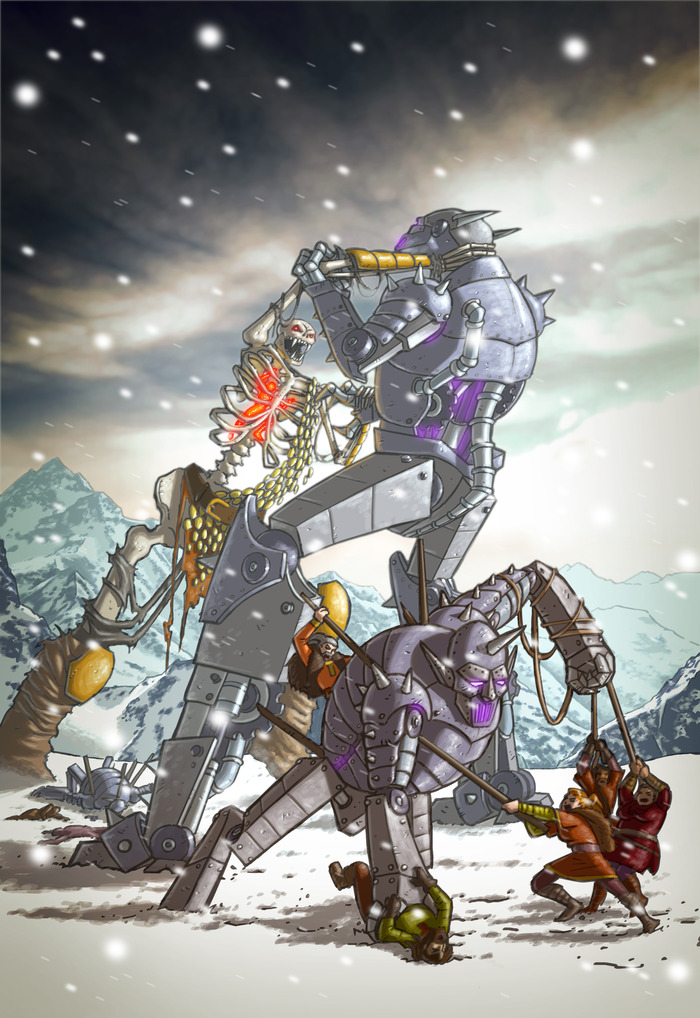Iron Edda: War of Metal and Bone is an ambitious project. At its most basic, it is a new RPG game designed around the Fate Core system and is currently being run over on Kickstarter. But, with over twenty stretch goals and an impressive roster of contributors, it could end up being much more than a setting. Tracy Barnett, the designer of War of Metal and Bone, was kind enough to answer some questions about his project.
Cold Winds And Hot Steel
Cardboard Republic: Thanks so much for answering some questions about Iron Edda: War of Metal and Bone. Before we get into the details, can you give us an overview of the game?
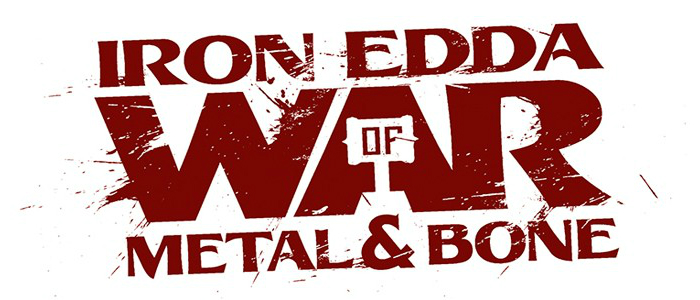 Iron Edda: War of Metal and Bone is a tabletop roleplaying game set in a world of Norse fantasy.
Iron Edda: War of Metal and Bone is a tabletop roleplaying game set in a world of Norse fantasy.
The dwarves and their Destroyers have risen from the ground, and Ragnarok is looming. Humans bond themselves to the bones of dead giants to fight back. It’s epic in scope, but it features very personal stories. The core game is written in Fate Core, which is perfect for the kinds of stories that game focuses on.
CR: I’ve heard a lot of great things about Fate Core lately. What made you decide to wrap your game around that system? Did you always know that you wanted to design a game around Fate Core, or did you have the world of Iron Edda worked out before you grafted it onto Fate Core?
I’ve been a fan of Fate for a while, specifically as it was used in the Dresden Files RPG. With Fate Core, they streamlined and made more accessible everything that I liked about it.
As far as Iron Edda and Fate go, the original idea was one that I wrote for another company [Apotheosis Drive X]. And they used Fate for it. Since they use open licensing for their work, it meant that I could take what was a small alternate setting called Bones of the Earth, and make it into a full game. And that’s what War of Metal and Bone is.
CR: How did the world of War of Metal and Bone come about? Your inspiration is obviously Norse mythology, but are there any particular tales or traditions that you pulled from?
As I mentioned above, I wrote the initial idea for the Apotheosis Drive X Kickstarter. That game is a more anime-influenced mecha game. When I pitched to write an alternate setting, I started thinking about how to do mecha in a fantasy setting.
I immediately thought of the video game Skyrim: norse influence, and crazy, dangerous dwarven ruins all through the world. From there, I amped up the size and presence of the dwarves. And the thought of humans bonding themselves to the bones of giants…well, it was just too cool of an idea to pass up.
As far as the Norse myth, I’m not drawing from many of the specific myths, but I am trying very hard to have the entire project read as ‘Norse’. It’s the flavor and the feel that I want to capture the most.
Also, the overwhelming theme of it all being Loki’s fault.
On Collaborative Storytelling
CR: Some RPGs favor a particular genre or type of story. Does War of Metal and Bone cater more toward any one breed of narrative?
Fate does an amazing job of highlighting the important parts of the characters in the game. Those parts are some of my favorite to explore in play, and doing that exploration on the backdrop of epic Norse fantasy and giant-sized things fighting each other is pretty awesome.
CR: Tell me a little bit about holdfast creation and the way players add to the map as they play the game.
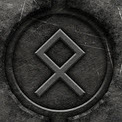 Another thing that’s very important to me as a GM is player investment. I don’t like just info-dumping stuff onto my players at the start of a campaign. I’d much rather have them contribute.
Another thing that’s very important to me as a GM is player investment. I don’t like just info-dumping stuff onto my players at the start of a campaign. I’d much rather have them contribute.
To that end, at the start of the campaign, the players answer pre-generated questions about the settlement in which they live: their holdfast. With each answer, the players add to a common map of the area that they’re building. And as the events of the campaign go on, things get added to and changed on the map. It becomes a living document of the game.
And I’d be remiss if I didn’t give credit where it’s due. My friend Travis Scott came up with the question-asking idea, and the map is inspired by Joe McDonaldo’s game The Quiet Year.
Laying The Groundwork
CR: You have some great talent associated with this project: Ryan Macklin, Lillian Cohen-Moore, and Quinn Murphy are all writing adventures for the core book, Jess Banks is providing a “mythology primer,” and that’s just to name a few. What made you choose to work with these writers and artists? What will they be bringing to the setting?
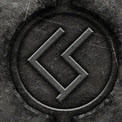 I chose them because I think they’re amazing. Everyone who is on this project has something to offer, whether they’re a seasoned writer and developer, or a first-timer. One of the things that I strove for when choosing the team I chose was to have broad representation of people, viewpoints, backgrounds, and life experiences. I think that having a diverse and representative team allows the entire project to be stronger on the whole.
I chose them because I think they’re amazing. Everyone who is on this project has something to offer, whether they’re a seasoned writer and developer, or a first-timer. One of the things that I strove for when choosing the team I chose was to have broad representation of people, viewpoints, backgrounds, and life experiences. I think that having a diverse and representative team allows the entire project to be stronger on the whole.
CR: You dedicate a chunk of your Kickstarter page to saying that you hope gamers of all backgrounds will feel comfortable playing War of Metal and Bone. What specific design decisions have you made to ensure that the setting is inclusive and welcoming?
I’ve been very intentional in my representations of people in both the art and the setting content. I make sure to include descriptions and references to the wide variety of races, gender identities, sexual orientations, and other important personal touchstones so that everyone will be able to find a home in the game. It’s something that I think that more game designers and developers could choose to do. It would make the hobby more welcoming to everyone.
CR: Earlier this year you Kickstarted a novel set in this same world. How is the process of world-building different when writing a novel versus an RPG setting?
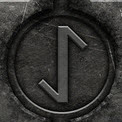 In a novel, everything is static. You get to decide what happens, where the characters go, and how events play out. That presents a different set of challenges from an RPG book. I’ll make the analogy like this: writing a novel is like building a house. You decide where things are going to go and you put them there.
In a novel, everything is static. You get to decide what happens, where the characters go, and how events play out. That presents a different set of challenges from an RPG book. I’ll make the analogy like this: writing a novel is like building a house. You decide where things are going to go and you put them there.
Writing an RPG is like coming up with some rough blueprints for the house, telling different constructions crews about the customization options, and handing them a set of tools. Ultimately, they both result in houses (the narrative that’s formed), but the process by which that narrative is formed is totally different.
CR: Time for the most important question: Will the game be available in retail stores or online for those who don’t back the Kickstarter? If so, when?
It will definitely be available for sale. The projected date right now is August of 2014, via DriveThruRPG.
Iron Edda aims to be a unique tabletop experience where it tries not to leave anyone out in the cold. Which is probably good, because we imagine in a Nordic-themed environment, it’s going to get a bit chilly. So grab a spot by the fire, put those feet up, and read more about this RPG over on their Kickstarter.
Photo Credits: Iron Edda artwork by Sand & Steam Productions.

